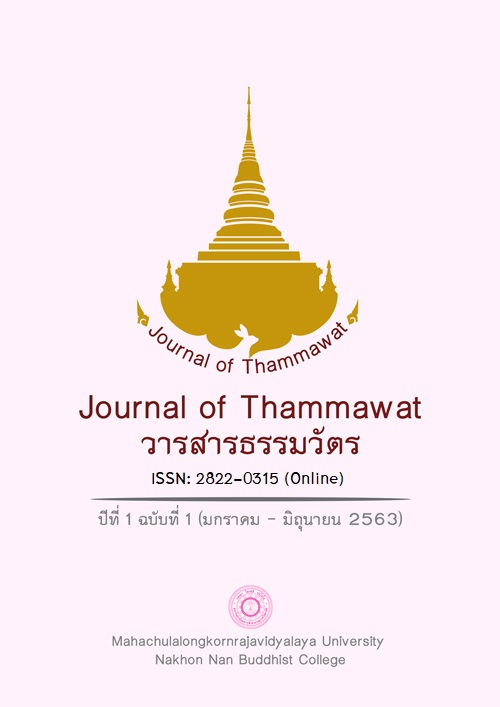A Study of Slangs Words in TV Pool Magazine
Main Article Content
Abstract
The purposes of the qualitative research on a study of slang words in TV Pool megazine were to 1) categorize slang words in TV Pool magazine based on the principle of wordsbuilding of Thai language and 2 ) study the meaning of slang words in TV Pool magazine (volume.1406, 30 July 2017 - volume.1430, 27 December 2017) from 24 copies. The findings revealed that: Many kinds of Slang words found in TV Pool magazine (volume.1406, 30 July 2017 - volume.1430, 27 December 2017) from 24 copies. The most common is the foreign language transliteration, followed by compound words, morphemes or single words, complex words, repetition words, and the least common is Bali or Sanskrit compound words. In terms of meanings of slang words found in TV Pool magazine (volume.1406, 30 July 2017 - volume.1430, 27 December 2017) from 24 copies, the most common is the denotation words, followed by implication words, and there is not any Bali and Sanskrit connection words. The research revealed that the class of word building, type of word, and meaning of slang words which are another language for communication in the society. Slang is a language used to communicate in a particular group, therefore; it is not generally used for most people.However, the results of this research causes benefit in terms of the studying and developing of slang words, moreover it develops the understanding in using slang words for new generations. Slang is classified as spoken language, but it is the interesting language. Slang is indicated as the changing of language, and the learning of slang words building since the most user is teenagers. It is because slang is the language that easily
comes and goes according to time.
Article Details

This work is licensed under a Creative Commons Attribution-NonCommercial-NoDerivatives 4.0 International License.
References
กอชาติ ชำนาญชาง. (2546). การศึกษาลักษณะคำสแลงของสาวประเภทสองในกรุงเทพมหานคร. (สารนิพนธ์การศึกษามหาบัณฑิต). มหาวิทยาลัยศรีนครินทรวิโรฒ.
กัญญนัช ชะนะจิตร. (2560). การสร้างคำและความหมายของสแลงในเฟซบุ๊ก. (วิทยานิพนธ์ศิลป ศาสตรมหาบัณฑิต). มหาวิทยาลัยธรรมศาสตร์.
จินตนา พุทธเมตะ. (2547). คำสแลง. วารสารมนุษยศาสตร์ปริทรรศน์. 26(1), 75-87.
ชัชนีย์ วินิจชัยนันท์. (2549). การวิเคราะห์คำศัพท์สแลงของชายที่มีจิตใจเป็นหญิง. (วิทยานิพนธ์ปริญญาอักษรศาสตรมหาบัณฑิต). มหาวิทยาลัยศิลปากร.
แนงนอย บุญยเนตร. (2548). การจดจำคำขวัญโฆษณาที่ใช้เสียงสัมผัส. วารสารนิเทศศาสตรปริทัศน์. 9(1), 9-18.
พรสวรรค์ สีป้อ. (2552). สุดยอดวิธีสอนภาษาอังกฤษ. กรุงเทพฯ: อักษรเจริญทัศน์.
ราชบัณฑิตยสถาน. (2553). พจนานุกรมคำใหม่ เล่ม 1 ฉบับราชบัณฑิตยสถาน. (พิมพ์ครั้งที่ 2). กรุงเทพฯ: ธนาเพรส.
ราชบัณฑิตยสถาน.. (2552). พจนานุกรมคำใหม่ เล่ม 2 ฉบับราชบัณฑิตยสถาน. กรุงเทพฯ: ยูเนียนอุลตร้าไวโอเล็ต.
ราชบัณฑิตยสถาน.. (2545). พจนานุกรมคำใหม่ เล่ม 3 ฉบับราชบัณฑิตยสถาน. กรุงเทพฯ: ยูเนียนอุลตร้าไวโอเล็ต.
วิไลวรรณ ขนิษฐานันท์. (2554). คนสุโขทัยยุคบุกเบิกมาจากลุ่มน้ำแดงในเวียดนาม: หลักฐานจากภาษาในปฏิทินโบราณและจารึกสุโขทัย. วารสารไทยคดีศึกษา, 8(2), 1-20.
สธนสรณ์ ยุติบรรพ์. (2555). ลักษณะการใช้และความหมายของภาษาสแลงในนิตยสารวัยรุ่น. (วิทยานิพนธ์ศิลปศาสตรมหาบัณฑิต). มหาวิทยาลัยศิลปากร.
วัลยา ช้างขวัญยืน และคณะ. (2553). บรรทัดฐานภาษาไทย เล่ม 2: คำ การสร้างคำ และการยืม. (พิมพ์ครั้งที่ 2). กรุงเทพฯ: กระทรวงศึกษาธิการ.
สุปรีดี สุวรรณบูรณ์. (2561). ภาษาเพื่อการสื่อสาร . สืบ ค้น เมื่อ 5 ธันวาคม 2561, จาก http://www.ipesp.ac.th/learning/thai/ Chapter3.html.


